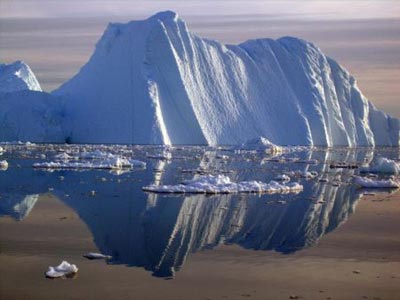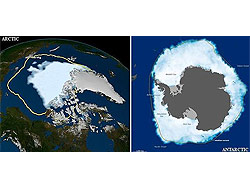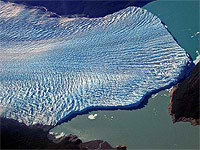El estudio detectó a través de las imágenes proporcionadas por los satélites al menos mil icebergs, algunos de ellos de decenas de kilómetros de diámetro, sobre una superficie de unos 12.500 kilómetros cuadrados.
En esos témpanos pululan, sobre un radio de más de 4 kilómetros, grandes comunidades de aves marinas que les sobrevuelan y todo un mundo de clorofila, fitopláncton, peces y krill.
Dióxido de carbono
Los icebergs albergan material terrestre que van liberando en el mar a medida que se derriten como resultado del aumento de la temperatura marina en su aproximación a latitudes más altas. Un resultado de ese proceso ha sido un aumento de casi un 40% en lo que los científicos califican como «productividad biológica» en la zona del mar de Weddell, un brazo del océano Atlántico que se incrusta en el continente antártico al sudeste del Cabo de Hornos. Un resultado de esta mayor «productividad» biológica es que los icebergs pueden absorber una cantidad importante del dióxido de carbono, el principal factor del calentamiento global.
Noticia completa en La Verdad (España)
Enlaces a sitios |
| |
Climbing Magazine Climbing Magazine"s Web site contains more than 30 years of rock and ice climbing news, climber profiles, technical information, and gear reviews. You"ll also find message boards, photo galleries, and classifieds
| Cold Regions Bibliography Between 1999 and 2000, this project was carried out under an Interagency Agreement between the Federal Research Division of the Library of Congress and the U.S. Army Cold Regions Research and Engineering Laboratory (CRREL).
|
Descent into the Ice A tem of "glacionauts" ventures into a labyrinth of unexplored anda hazardous glacier caves on France"s Mont Blanc
| Glacier and Permafrost Hazards in Mountains – GAPHAZ Scientific Working Group of the International Association of Cryospheric Sciences (IACS) and the International Permafrost Association (IPA). Department of Geosciences University of Oslo
|
Glacier hazards The experience and data on glacier disasters in Switzerland has been systematically collected in the past two decades, and historical sources were analyzed.
| Glacier Hazards From Space Glacier hazards represent a continuous threat to human lives and infrastructure in mountain regions.
|
Glacier Hazards in Perú The floods, known in Perú as aluviónes, come with little or no warning and are composed of liquid mud that generally transports large rock boulders and blocks of ice.
| Glaciers and Glacier Hazards Glaciers and Glacier Hazards Glaciers and Ice Sheets and Volcanic Eruptions, USGS/Cascades Volcano Observatory, Vancouver, Washington
|
Glaciers online Glaciers online offers photos and summary explanations concerning glaciers from all over the world. The primary goal of our project is to enrich and stimulate the teaching of Earth Science and Physical Geography, in particular glaciology.. Jürg Alean & Mi
| Global Land Ice Measurements from Space GLIMS (Global Land Ice Measurements from Space) is a project designed to monitor the world"s glaciers primarily using data from optical satellite instruments, such as ASTER (Advanced Spaceborne Thermal Emission and reflection Radiometer).
|











 Imagen: Agencias / Internet
Imagen: Agencias / Internet






